Gulf Fritillary - Agraulis vanillae
Gulf Fritillary Butterflies are flying in my garden most of the spring, summer and fall. There can be a dozen or more flying at any given time. This is as spectacular as the flowers on the passion vine that they eat. Fortunately the passion vine is extraordinarily exuberant in its growth and can usually keep up with the voracious appetites of the caterpillars. This Gulf Fritillary was slowed by a cool morning which made for some excellent viewing. The butterflies over-winter in their cocoons. These are light brown and attached to the bottom of most any fixed object including chairs, deck rails, and the bottoms of the leaves. The passion vine grows glands that mimic butterfly eggs on the leaves and petioles in an effort to dissuade the Gulf Fritillary Butterfly's from laying their eggs. Gulf Fritillary eggs can be found on the underside of the passion vine leaves or of the leaves of nearby plants. We have an extensive list of plants that will attract these beauties to your butterfly garden.
A walk through my garden taking time to smell the roses and watch a hummingbird and Gulf Fritillary pollenate Scabiosa Black Knight
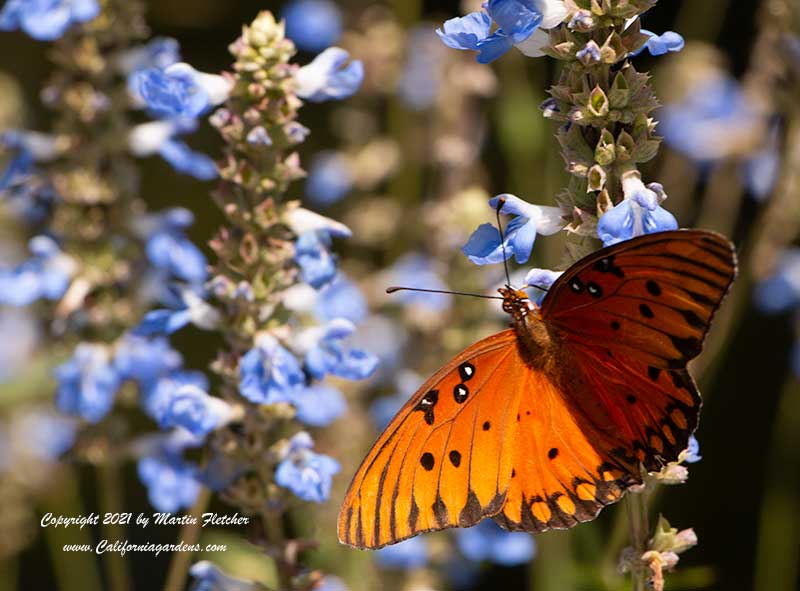
Gulf Fritillary Butterfly - Nectaring on Salvia uliginosa, Blue Spike Sage flowers. High resolution photos are part of our garden image collection.
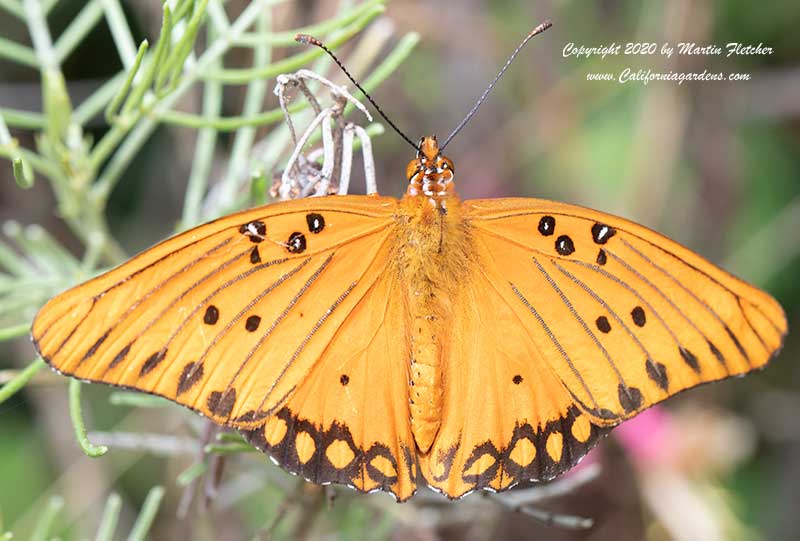
Gulf Fritillary Butterfly - Top View. High resolution photos are part of our garden image collection.
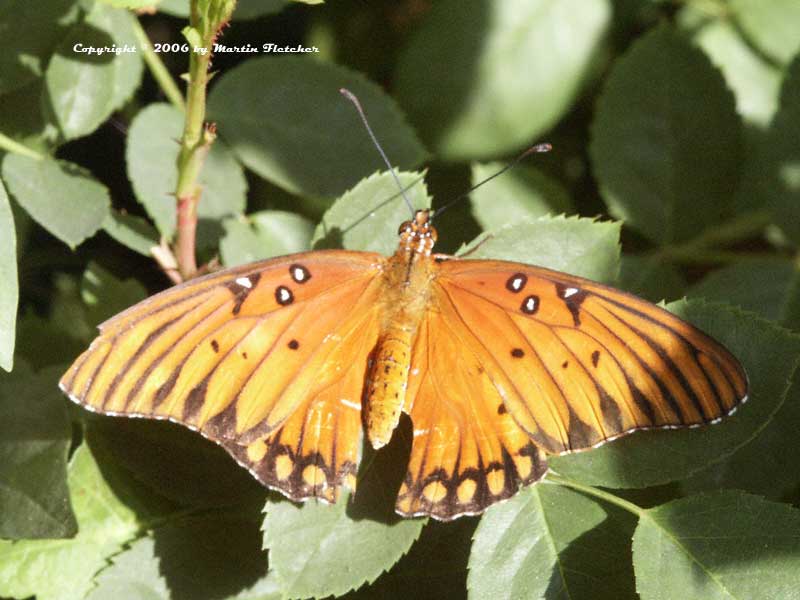
Gulf Fritillary Butterfly - Top View. High resolution photos are part of our garden image collection.
I liked the attitude of the head and antennae. Butterfly antennae are smooth. Moth antennae are feathered. You can see the proboscis (tongue) curled in front of the eyes. The adult Gulf Fritillary will feed on a wide variety of nectar rich plants. This Gulf Fritillary was hiding behind some plants next to the house trying to stay warm. It was a foggy cool day, likely not warm enough for their metabolism to produce enough energy to fly.
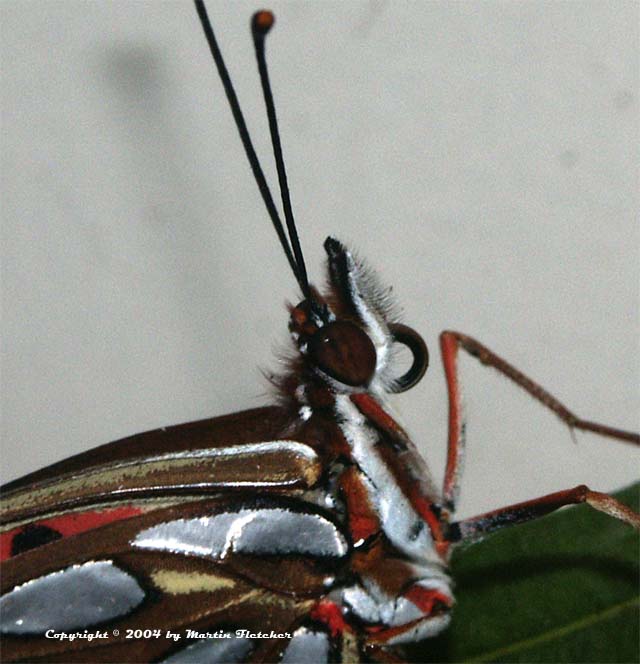
Gulf Fritillary Profile.
Gulf Fritillary Butterflies are in my yard most of the spring, summer and fall, activity dramatically slows for the winter, as most of the Butterflies over-winter in chrysalis form. They have numerous generations each year. The Gulf Fritillary will lay her eggs on the underside of the Passion Vine leaves and occasionally on nearby plants. Passion vines generate egg mimic glands that are supposed to inhibit egg laying. It is not completely successful. Nor for the sake of the Gulf Fritillary Butterfly would we want it to be. Gulf Fritillary eggs may hatch in as little as 3 days. The eggs start out yellow and darken as they age.
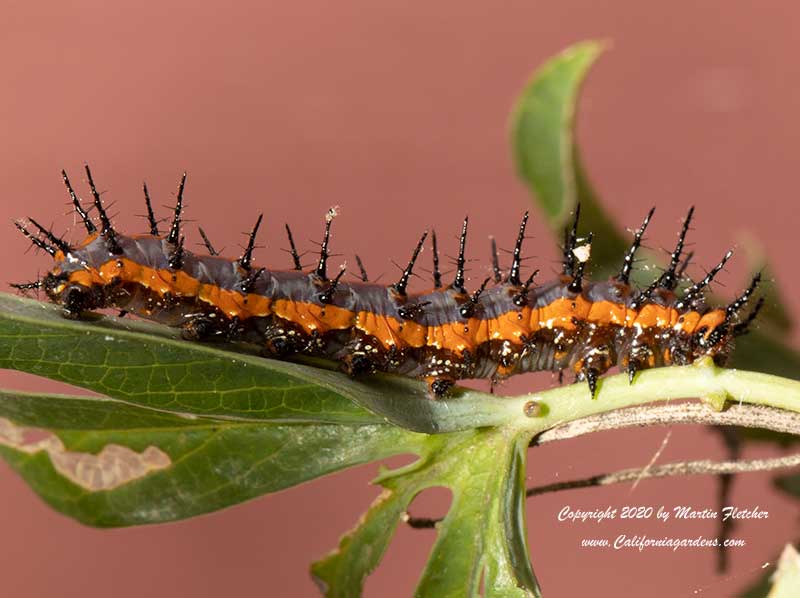
Gulf Fritillary Caterpillar it is interesting how hard it is to tell the front from the back.
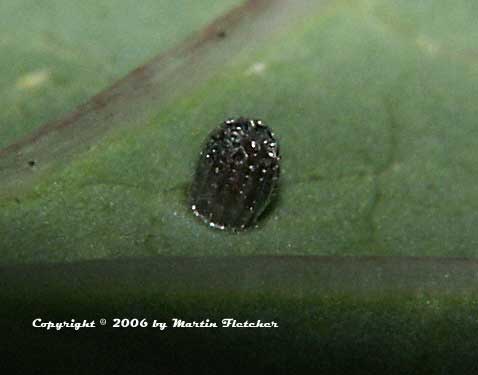
Gulf Fritillary Egg - Egg photo (478 x 375 pixels).
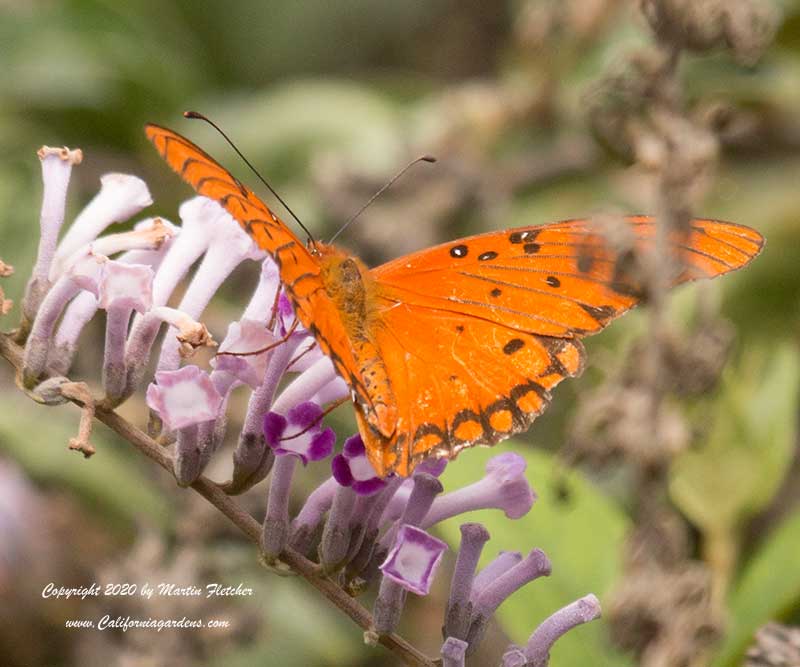
Flowers and foliage of Buddleia lindleyana the Weeping Butterfly Bush with a nectaring Gulf Frittilary Butterfly. High resolution photos are part of our garden image collection.
Some plants to attract the Gulf Fritillary to your garden. Plants in the Buddleia genus featured on this site:
Apocynum cannabinum * Dogbane
Buddleia davidii Black Knight * Black Knight Butterfly Bush
Buddleia davidii Harlequin * Harlequin Variegated Butterfly Bush
Buddleia davidii Lochinch * Lochinch Butterfly Bush
Buddleia davidii Miss Molly * Miss Molly Butterfly Bush
Buddleia davidii Nanho Purple * Nanho Purple Butterfly Bush
Buddleia davidii Pink Delight * Pink Delight Butterfly Bush
Buddleia davidii White Profusion * White Profusion Butterfly Bush
Buddleia lindleyana * Weeping Butterfly Bush
Buddleia marrubifolia * Woolly Butterfly Bush
Buddleia weyeriana Honeycomb * Honeycomb Butterfly Bush
Eriodictyon tomentosum * Woolly Yerba Santa
Lonicera ciliosa * Orange Honeysuckle * Western Trumpet Honeysuckle
Lonicera involucrata * Twinberry
Lonicera japonica * Japanese Honeysuckle
Lonicera japonica purpurea * Purple Leaf Japanese Honeysuckle
Lonicera subspicata denudata * Chaparral Honeysuckle
Monarda fistulosa * Wild Bergamont
Passiflora alata
Passiflora citrina
Passiflora Constance Elliott
Passiflora Coral Sea
Passiflora edulis
Passiflora Incense
Passiflora Lavender Lady
Passiflora sanguinolenta
Passiflora vitifolia
Scabiosa atropurpurea Black Knight * Black Knight Pincushion Flower
Scabiosa atropurpurea Royal Ruby * Royal Ruby Pincushion Flower
Scabiosa caucasica Fama Deep Blue * Deep Blue Pincushion Flower
Scabiosa causasica Perfecta Blue * Perfecta Blue Pincushion Flower
Scabiosa columbaria Butterfly Blue * Butterfly Blue Pincushion Flower
Scabuisa columbaria Pink Mist * Pink Mist Pinchushion Flower
Scabisoa cretica * Balaeric Pincushion Flower
Scabiosa farinosa * Dwarf Pincushion Flower
Scabiosa ochroleuca * Yellow Pincushion Flower
